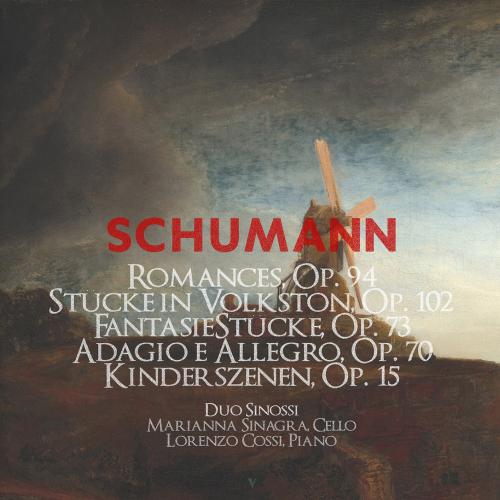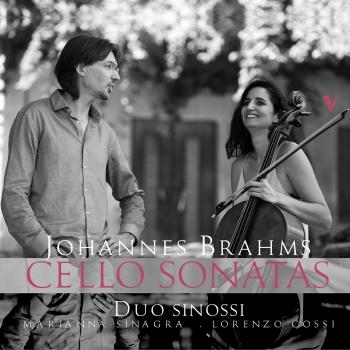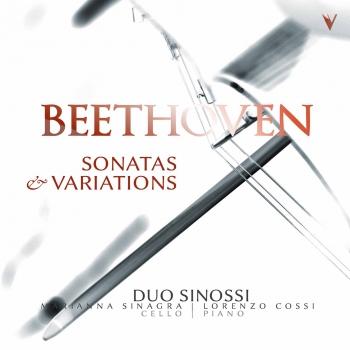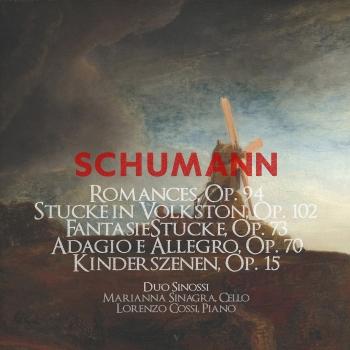
R. Schumann: Complete Works for Cello & Piano Duo Sinossi
Album info
Album-Release:
2022
HRA-Release:
02.12.2022
Label: OnClassical
Genre: Classical
Subgenre: Chamber Music
Artist: Duo Sinossi
Composer: Robert Schumann (1810-1856)
Album including Album cover
- Robert Schumann (1810 - 1856): 3 Romances for Oboe & Piano, Op. 94 (Arr. for Cello & Piano):
- 1 Schumann: 3 Romances for Oboe & Piano, Op. 94 (Arr. for Cello & Piano): No. 1, Nicht schnell 03:58
- 2 Schumann: 3 Romances for Oboe & Piano, Op. 94 (Arr. for Cello & Piano): No. 2, Einfach, innig 04:26
- 3 Schumann: 3 Romances for Oboe & Piano, Op. 94 (Arr. for Cello & Piano): No. 3, Nicht schnell 04:46
- 5 Stücke im Volkston for Piano & Violoncello, Op. 102:
- 4 Schumann: 5 Stücke im Volkston for Piano & Violoncello, Op. 102: No. 1, Mit humor 03:15
- 5 Schumann: 5 Stücke im Volkston for Piano & Violoncello, Op. 102: No. 2, Langsam 04:14
- 6 Schumann: 5 Stücke im Volkston for Piano & Violoncello, Op. 102: No. 3, Nicht schnell, mit viel Ton zu spielen 04:22
- 7 Schumann: 5 Stücke im Volkston for Piano & Violoncello, Op. 102: No. 4, Nicht zu rasch 02:18
- 8 Schumann: 5 Stücke im Volkston for Piano & Violoncello, Op. 102: No. 5, Stark und markiert 03:11
- Fantasiestücke for Clarinet & Pianoforte, Op. 73 (Version for Cello & Piano):
- 9 Schumann: Fantasiestücke for Clarinet & Pianoforte, Op. 73 (Version for Cello & Piano): I. Zart und mit Ausdruck 03:43
- 10 Schumann: Fantasiestücke for Clarinet & Pianoforte, Op. 73 (Version for Cello & Piano): II. Lebhaft, leicht 03:55
- 11 Schumann: Fantasiestücke for Clarinet & Pianoforte, Op. 73 (Version for Cello & Piano): III. Rasch und mit Feuer 04:49
- Adagio & Allegro for Horn & Piano, Op. 70 (Version for Cello & Piano):
- 12 Schumann: Adagio & Allegro for Horn & Piano, Op. 70 (Version for Cello & Piano): I. Adagio 04:40
- 13 Schumann: Adagio & Allegro for Horn & Piano, Op. 70 (Version for Cello & Piano): II. Allegro 05:10
- Kinderszenen, Op. 15 (Arr. for Cello & Piano):
- 14 Schumann: Kinderszenen, Op. 15 (Arr. for Cello & Piano): No. 1, Von fremden Ländern und Menschen 01:48
- 15 Schumann: Kinderszenen, Op. 15 (Arr. for Cello & Piano): No. 2, Kuriose Geschichte 01:16
- 16 Schumann: Kinderszenen, Op. 15 (Arr. for Cello & Piano): No. 3, Hasche-Mann 00:36
- 17 Schumann: Kinderszenen, Op. 15 (Arr. for Cello & Piano): No. 4, Bittendes Kind 01:01
- 18 Schumann: Kinderszenen, Op. 15 (Arr. for Cello & Piano): No. 5, Glückes genug 00:47
- 19 Schumann: Kinderszenen, Op. 15 (Arr. for Cello & Piano): No. 6, Wichtige Begebenheit 00:53
- 20 Schumann: Kinderszenen, Op. 15 (Arr. for Cello & Piano): No. 7, Träumerei 03:19
- 21 Schumann: Kinderszenen, Op. 15 (Arr. for Cello & Piano): No. 8, Am Kamin 01:03
- 22 Schumann: Kinderszenen, Op. 15 (Arr. for Cello & Piano): No. 9, Ritter vom Steckenpferd 00:42
- 23 Schumann: Kinderszenen, Op. 15 (Arr. for Cello & Piano): No. 10, Fast zu ernst 02:01
- 24 Schumann: Kinderszenen, Op. 15 (Arr. for Cello & Piano): No. 11, Fürchtenmachen 02:03
- 25 Schumann: Kinderszenen, Op. 15 (Arr. for Cello & Piano): No. 12, Kind im einschlummern 02:11
- 26 Schumann: Kinderszenen, Op. 15 (Arr. for Cello & Piano): No. 13, Der Dichter spricht 02:19
Info for R. Schumann: Complete Works for Cello & Piano
Originally written for oboe (unique composition for this instrument), the "Drei Romanzen", Op. 94 were composed in late 1849 when Schumann seemed to be inspired by old legends.
Same character has the "Fünf Stücke im Volkston", Op. 102, of the same year. The pieces proved more challenging to Schumann as they took over two weeks to compose. “Folk style” is meant as "a way of telling an intensely imagined narrative."
The "Fantasiestücke", Op. 73, also composed in 1849, were indented for clarinet (and piano). The title promotes the fundamental romantic notion that creative expression is the product of the artist's unrestricted imagination. In addition, the connotations of "fantasy" justify the sudden mood changes.
In the same year, again, Schumann composed the Adagio and Allegro Op. 70, a chamber music piece indented for horn (and piano). Schumann planned alternative editions - before it was printed - in which the horn or cello or violin can be replaced.
Shortly after this work was completed, Clara Schumann commented that it was "just the sort of piece that I like, brilliant, fresh and passionate."
Despite the fact Schumann, in 1849, was suffering of manic episodes, these pieces were written in one of the most productive years of his entire career!
Kinderszenen ("Scenes from Childhood"), Op. 15, by Robert Schumann, is a (notable) set of thirteen pieces of music for piano written in 1838.
Schumann wrote 30 movements for this work but chose 13 for the final version. The unused movements were later published in Bunte Blätter, Op. 99, and Albumblätter, Op. 124.
Movement No. 7 of the work, Träumerei (Dreaming), is one of Schumann's best known pieces.
Marianna Sinagra, cello and Lorenzo Cossi, piano, form a well known duo in Italy, the Duo Sinossi. Both members were winners of several international competition. This is their third official recording (all were made by label OnClassical).
Marianna Sinagra, cello
Lorenzo Cossi, piano
Lorenzo Cossi
has been recently internationally acclaimed as one of the five finalists at the Honens
International Piano Competition in Calgary, Canada.
His performance of the Brahms first Piano Concerto in D minor with the Calgary Philharmonic Orchestra under the baton of Roberto Minczuk received a standing ovation at the beautiful Jack Singer Concert Hall.
The Cincinnati Enquirer wrote “Cossi’s technique and command of sonority were simply stunning. He produced lush, orchestral sounds and performed amazing feats, but always with a refined touch”.
Lorenzo was born in Trieste, Italy, and completed his studies at the local Conservatory, under the guideance of Giuliana Gulli, sister of the beloved violinist Franco Gulli.
His musical education has been developed with other important artists, such as Nino Gardi, Elisso Virsaladze, Joaquìn Achùcarro, William Grant Naborè and Jerome Lowenthal.
He had the opportunity to study at the International Piano Academy “Lake Como” and the “Accademia Chigiana” in Siena.
In 2011 he was one of the ten pianists selected worldwide to take part to the Music Academy of the West summer Festival in Santa Barbara, California.
His repertoire ranges from the baroque era to contemporary music, with a special interest for Jazz and many other styles.
Lorenzo has always been fascinated by chamber music, and he collaborates with many important musicians (he played with cellist Johannes Moser, violinist Federico Agostini and Geoff Nuttal, soprano Amanda Roocroft).
In particular, he regularely plays with cellist Marianna Sinagra, a partnership dating back to 2009.
The Sinagra-Cossi Duo recently won third prize at the “V. Gui” International Chamber Music Competition in Firenze, one of the most important competitions of this kind.
A prize winner of the “Rina Sala Gallo competition” in Monza, the “G. Pecar” competition in Gorizia and many others, Lorenzo was twice finalist at the prestigious International “F. Busoni” Piano competition in Bolzano.
In November 2014 he performed Scriabin’s masterpiece Prometheus (Poem of Fire) in Luxembourg with the Luxembourg Philharmonie conducted by Emilio Pomarico.
This album contains no booklet.















